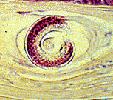|
|
| (27 intermediate revisions by 4 users not shown) |
| Line 1: |
Line 1: |
| − | {{OpenPagesTop}}
| + | == ''Trichinella'' == |
| − | {{Podcasts
| + | [[Image:Trichinella spiralis H and E.jpg|thumb|right|150px|''Trichinella spiralis'' stained with H and E - Courtesy of the Laboratory of Parasitology, University of Pennsylvania School of Veterinary Medicine]] |
| − | |link = http://media.bloomsburymediacloud.org/podcasts/wikivet-english/trichinella
| + | [[Image:Trichinella spiralis.jpg|thumb|right|150px|''Trichinella spiralis'' - Courtesy of the Laboratory of Parasitology, University of Pennsylvania School of Veterinary Medicine]] |
| − | }}
| + | *This is known as the "worm that thinks its a virus" |
| − | ==Introduction== | + | *It is an important zoonosis |
| − | [[File:Trichinella larvaeD.jpg|thumb|200px|right|''Trichinella'' in tissues. Sourced from Wikimedia commons.]] | + | *It is covered in greater detail |
| − | ''Trichinella spiralis'' is a '''[[Helminths |helminth]] parasite''' of the ''[[Trichinelloidea]]'' superfamily. It is unique among helminths as it is '''intracellular''' and requires '''only one host'''. | |
| | | | |
| − | Disease is most important in pigs and wild boar due to its '''zoonotic''' transmission through eating '''pork'''. <u>'''Trichinellosis'''</u> is a '''serious public health hazard'''.
| + | *''Trichinella'' in [[Muscles Inflammatory - Pathology#Nematodes|myositis]] |
| − | | |
| − | The trichinae are widespread across all continents. ''T. spiralis'' is found in temperate Europe, Asia, New Zealand, North and South America.
| |
| − | | |
| − | This disease is '''notifiable''' to the World Organisation for Animal Health [http://www.oie.int/ (OIE)]
| |
| − | | |
| − | ==Lifecycle==
| |
| − | The lifecycle of ''T. spiralis'' is direct. Larvae are ingested by the pig through scavenging or predation. '''Free range''' outdoor pigs are therefore at highest risk. [[Monogastric Stomach - Anatomy & Physiology |'''Gastric digestion''']] releases the larvae from the infected muscle tissue.
| |
| − | They then undergo moults and '''copulate''' in the '''small intestine''' after which the males die and the '''females penetrate''' into the intestinal '''mucosa'''.
| |
| − | | |
| − | The females then produce more '''larvae''' which can '''disseminate''' through the host in the blood and lymphatics, localising in the '''striated muscles'''. In pigs and wild boars, preferential sites appear to be the '''[[Diaphragm - Anatomy & Physiology|diaphragm]], [[Mastication#Muscles of Mastication|masseters]] and [[Tongue - Anatomy & Physiology|tongue]].''' The muscle cells are transformed by the larvae within them, to form '''nurse cells''' which can supply '''nutrition''' and protects the larvae in a '''collagen capsule'''. Larvae can then survive in frozen and decaying carcasses forming an important route of transmission.
| |
| − | | |
| − | Humans are infected by eating '''raw or undercooked meat''' containing the infective larvae.
| |
| − | | |
| − | ==Pathogenesis==
| |
| − | Damage is caused by '''penetrating female larvae''' in the small intestine and '''dissemination of larvae''' into the muscle masses. The degree of damage is dependent upon pathogen load.
| |
| − | | |
| − | ==Diagnosis==
| |
| − | '''Direct microscopy''' of muscle samples between two glass plates can detect the organism.
| |
| − | | |
| − | Digestion with '''pepsin-HCl''' or '''[[ELISA testing]]''' is also possible.
| |
| − | | |
| − | ==Diseases==
| |
| − | Trichinellosis is usually '''subclinical in pigs''', forming muscular cysts.
| |
| − | | |
| − | Large burdens may cause '''enteritis''' followed by '''[[Parasitic Myositis |myositis]]''', fever and '''[[Myocarditis |myocarditis]]''' which can be fatal.
| |
| − | | |
| − | '''Human disease''' is serious and sometimes fatal, causing '''myositis, myocarditis, encephalitis and facial oedema.'''
| |
| − | | |
| − | ==Control==
| |
| − | '''[[Anthelmintic Drugs|Anthelmintics]]''' can be used both as a treatment and control method for trichinellosis. Prevention of scavenging and feeding appropriate feedstuffs to pigs forms a major part in controlling the disease as well as meat inspection and destruction wherever trichinellosis is found.
| |
| − | | |
| − | '''Sampling of the diaphragm''' in the abattoir is performed routinely in most countries.
| |
| − | | |
| − | | |
| − | {{Learning
| |
| − | |flashcards = [[Trichinella Flashcards | ''Trichinella'' Flashcards]]
| |
| − | }}
| |
| − | | |
| − | | |
| − | ==References==
| |
| − | <references/>
| |
| − | {{CABI source
| |
| − | |datasheet = [http://www.cabi.org/ahpc/?compid=3&dsid=96878&loadmodule=datasheet&page=2144&site=160 Trichinella]
| |
| − | |date = 8 June 2011
| |
| − | }}
| |
| − | <br><br>
| |
| − | | |
| − | {{Mandy Nevel
| |
| − | |date = 09 September 2011
| |
| − | }}
| |
| − | | |
| − | {{OpenPages}}
| |
| | | | |
| | [[Category:Trichinelloidea]] | | [[Category:Trichinelloidea]] |
| − | [[Category:Intestinal Diseases - Pig]][[Category:Musculoskeletal Diseases - Pig]][[Category:Cardiovascular Diseases - Pig]]
| |
| − | [[Category:Pig_Nematodes]][[Category:Zoonoses]][[Category:CABI Expert Review Completed]][[Category:CABI AHPC Pages]]
| |
| − | [[Category:Cardiology Section]]
| |

